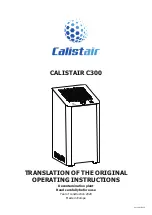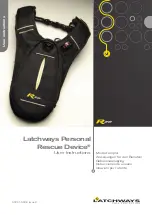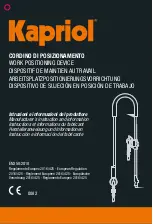
PO BOX 1909, ROHNERT PARK, CA 94927-1909, U.S.A. • PHONE 707-588-2000 • FAX 707-588-2020
tion from the earlier injection. This liquid will
exit out vent tube 5.
b) Follow steps a-d in Section 8.0.
10.0 ADJUSTING FOR HIGHER PRES-
SURE OPERATION/LEAKAGE
The valve has been factory-set to hold 345
bar. If you need operation to a higher pressure
or if there is a leak between stator and stator
ring proceed as follows.
With the system pressurized, back the three
set screws part-way out of the stator. Tighten
each of the three stator screws 1/8 of a turn,
continue to do so until the leak stops and the
valve is holding the pressure you want.
Confirm that the gap between the stator and
stator ring is equal around the valve. After the
leak has stopped tighten the set screws until
they touch the stator ring. Replace the rotor
seal if the leak continues.
NOTE: If the vent tubes from ports 5 and
6 do not have their outlet ends at the same
horizontal level as the needle port, siphoning
can result, which is often misinterpreted as
a leak.
11.0 MAINTENANCE
With normal use the valve will give many
thousands of injections without trouble. The
rotor seal wears with use and is the only part
that needs routine replacement. The main
causes of early failure are:
a) the wrong needle tip can chip the
ceramic stator face which then causes deep
scratching of the rotor seal surface or,
b) abrasive particles in the sample can
scratch the rotor seal surface.
11.1 CHANGING THE ROTOR SEAL
To change the rotor seal (P/N 7125-047)
refer to Fig. 5 and proceed as follows:
a) Remove the three stator screws.
b) Remove the stator, stator face assembly
and stator ring from the body.
c) Pull the rotor seal off the pins.
d) Leave isolation seal and bearing ring in
place. See Section 12.2 for reassembly.
11.2 REASSEMBLY
To reassemble the valve proceed as
follows and refer to Fig. 5:
a) Line up rotor seal as shown in Fig. 6.
The rotor seal slots face the stator.
b) Replace the stator ring so that the two
stop pins enter the mating holes in the body.
The rotor pin must be between the two stop
pins.
c) Put the stator face assembly on the
stator. Line up the small notch in the rim of the
assembly with port 1 of the stator.
d) Mount the stator and stator face
assembly on the valve by pushing it onto the
two pins on the stator ring.
f) Put the three stator screws in place.
Tighten each an equal amount until the screws
are tight. The three set screws will keep the
space even between the stator and stator ring.
11.3 SPARE PARTS
7125-047 Vespel Rotor Seal (standard)
7125-079 Tefzel Rotor Seal (high pH)
12.0 OPERATING SUGGESTIONS AND
TROUBLESHOOTING
12.1 LEAKAGE
If you see liquid between the stator and
stator ring, tighten the pressure adjusting screw
as explained in Section 11.0. Replace the
rotor seal if the leak continues.
12.2 NEEDLE SEAL LEAKAGE
Since the outside diameter of syringe
needles can be different from syringe
tosyringe, the needle seal (Teflon sleeve in the
rotor seal) may not seal correctly around a
needle which is smaller than average. This
will result in a loss of accuracy in loading
the sample.
12.3 USE OF AQUEOUS BUFFERS OR
SALT SOLUTIONS
To prevent the formation of salt crystals in
the valve, flush out the flow passages and the
injection port with water after using salt
solutions.
12.4 USE OF HIGH pH SOLUTIONS
The standard rotor seal is Vespel, a
polyimide with good wear resistance. It
is sensitive to alkaline attack, so avoid
solutions having a pH of 10 or more. Use the
Tefzel rotor seal for alkaline solutions (see
Section 11.3).
12.5 ACCURACY OF SAMPLE LOOPS
Sample loop sizes are not actual values. The
actual volume can differ by up to 10% for a
20-uL loop. There is a greater difference for
smaller loops. Use partial filling if you must
know the actual volume injected.
13.0 WARRANTY
All Rheodyne valves are warranted
against defects in materials and workman-
ship for a period of one year following date
of shipment by Rheodyne. Rheodyne will
repair or replace any Rheodyne product
that fails to conform to the foregoing war-
ranty, at no charge to the customer, provided
that the valve is returned to Rheodyne's
factory, transportation prepaid. The forego-
ing is Rheodyne's sole warranty of its prod-
ucts, and all other warranties, express or
implied, including any implied warranties
of merchantability or fitness for any particu-
lar purpose are hereby disclaimed. Under no
circumstances will Rheodyne be liable for
any consequential or incidental damages
attributable to any Rheodyne valves, even if
Rheodyne has been placed on notice of the
possibility of such damages.
14.0 RETURN OF VALVES
Products may not be returned which are
radioactive or contaminated by infectious
agents, or other materials that may constitute
health hazards to Rheodyne employees.
Figure 5: Model 7125 Exploded View
Notch
Stop Pins
Figure 6: Rotor Seal Orientation (view from stator)
Handle Assembly
Thrust Bearing
Body
Set Screws (3)
Stator Ring
Stop Pins (2)
Rotor Seal
Isolation Seal
(spring loaded)
Bearing Ring
Needle Port Tube
Assembly
Spring Washers (4)
Needle Seal
Stator
Stator Face Assembly
Stator Screws (3)
Rotor Pin
Seal Pins (4)
Needle Guide




















